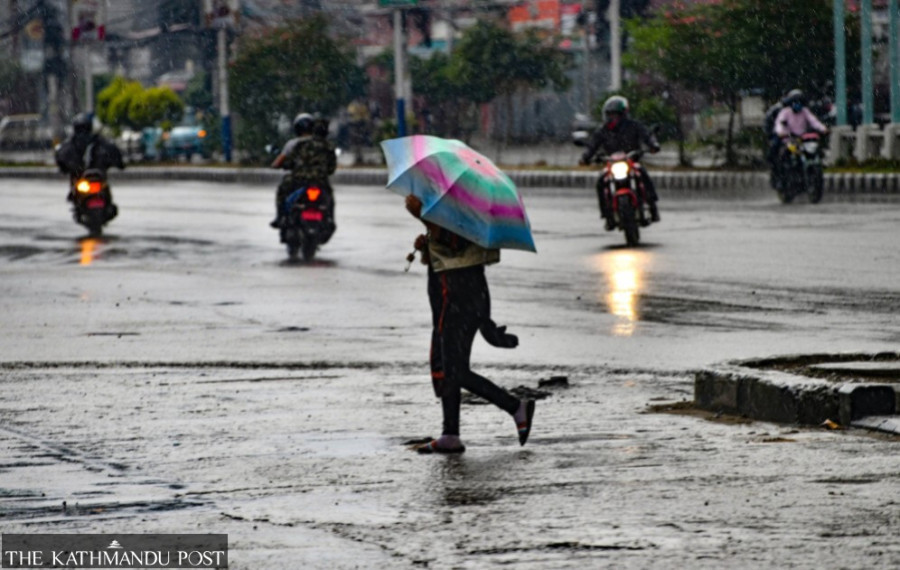Columns
Addressing monsoon-induced disasters
Nepal can draw valuable lessons from its past mistakes to inform its future measures.
Hari Bansh Jha
Nepal experiences nearly 80 percent of its total annual precipitation during the monsoon season, which normally spans from June to September. The monsoon is a double-edged sword for the country, bringing blessings and hardships.
On the positive side, the rains sustain agriculture, replenish vital water resources and support the livelihoods of millions in rural areas. However, the same torrential rains also unleash destructive floods and landslides, causing significant damage to life, property and infrastructure. The situation is often exacerbated by human-induced factors, such as unplanned urbanisation, deforestation and poorly managed infrastructure development, which obstruct the natural water flow and worsen the impact of monsoon-related disasters.
In 2024, Nepal experienced record-breaking rainfall in September, surpassing a 50-year precedent. The heavy rains triggered severe floods and landslides across the country, with 26 of Nepal's 77 districts being severely affected. In response to the scale of the devastation, the government declared these districts disaster crisis zones, allowing for a faster mobilisation of resources and relief efforts. The floods damaged roads, destroyed bridges, disrupted drinking water supplies and crippled telecommunications networks, leaving thousands of people stranded and vulnerable. Moreover, 16 hydropower plants, responsible for generating 667.9 MW of electricity, were severely damaged, along with key transmission lines, further crippling Nepal's already fragile energy sector.
The human toll of the disaster was profound. A total of 244 lives were lost, 19 people were reported missing, and 179 others were injured. Over 17,774 individuals were rescued by government and security forces, including the Nepal Army, Armed Police Force and local volunteers. Despite their efforts, relief distribution was slow, leaving many families waiting for essential assistance. The government pledged Rs200,000 in compensation to families who had lost loved ones, and financial support was directed to local units for disaster management. However, the sheer scale of the disaster overwhelmed the government's capacity to respond effectively.
The economic consequences of the disaster were equally devastating. The estimated financial losses exceeded Rs17 billion, with damage of Rs6 billion in the agriculture sector alone. As agriculture is the backbone of Nepal’s rural economy, the disruption is expected to increase food imports, further widening the country's trade deficit. The energy sector, already under strain, suffered Rs4 billion worth of damages, which will likely force Nepal to import electricity from India to compensate for the loss in hydropower production. Additionally, tourism, another vital sector of the economy, was negatively impacted, and the increased budgetary pressure on the government will worsen an already delicate fiscal situation.
As a result of the disaster, Nepal’s GDP is projected to contract by 1 percent, representing a loss of Rs57 billion. This will also reduce the country’s economic growth rate, which was previously estimated at 4.9 percent by the Asian Development Bank. With the increased debt obligations and a growing trade deficit, Nepal's economic outlook remains precarious.
The international community responded swiftly to Nepal’s crisis. Indian Prime Minister Narendra Modi expressed solidarity with Nepal, assuring that India would stand by Nepal in its time of need and offer all possible cooperation to help overcome the disaster. India, Nepal’s immediate neighbour, quickly dispatched essential supplies, including medicines, food, hygiene products and emergency equipment. India's significant role in Nepal’s disaster management has been recognised globally, particularly for its assistance during the 2015 and 2023 earthquakes in Jajarkot. China also expressed condolences for the human casualties and property losses caused by the disaster. Additionally, China provided emergency supplies, including blankets, rice, and other essential goods for those affected. Other countries, such as the United Kingdom and Russia, also expressed their grief.
Beyond bilateral support, international organisations also played a critical role in disaster relief efforts. The World Bank approved $150 million in emergency funding to support victims affected by the floods and landslides. Numerous other donor agencies and countries offered financial aid, highlighting the global concern for Nepal’s plight.
However, the disaster emphasised significant weaknesses in Nepal’s disaster preparedness. The damage was intensified by inadequate infrastructure and unregulated construction in vulnerable areas. The government’s short-term rescue and relief efforts weren’t that effective, and long-term planning to address disaster risk reduction remains largely underdeveloped.
Monsoon-induced disasters are not a new challenge for Nepal; however, climate change is increasing the frequency and intensity of such events. The 2024 floods underscore the urgent need for comprehensive disaster management policies that prioritise disaster preparedness, sustainable urban development, and environmental conservation.
Moving forward, the Nepali government must focus on several critical areas. First, enhancing early warning systems is essential to ensure communities receive timely information about potential floods and landslides. Second, investing in flood management infrastructure—such as embankments, retention basins and better drainage systems—helps mitigate the effects of heavy rainfall. Third, construction activities should be regulated in flood-prone areas to prevent the uncontrolled development that often leads to increased disaster vulnerability.
Additionally, Nepal must also focus on sustainable land-use practices. Reforestation initiatives and the promotion of sustainable agriculture can help restore ecosystems and reduce the risk of landslides while also improving the resilience of rural communities to future monsoon-induced disasters. Furthermore, long-term collaboration with international donors and organisations will be critical in rebuilding stronger and more resilient communities.
Nepal can draw valuable lessons from past mistakes to inform proactive measures for the future. Prioritising disaster risk reduction and investing in sustainable development, Nepal can better prepare for the monsoon season and ensure that rainfall’s benefits are maximised while minimising the devastating consequences of floods and landslides.




 13.12°C Kathmandu
13.12°C Kathmandu















